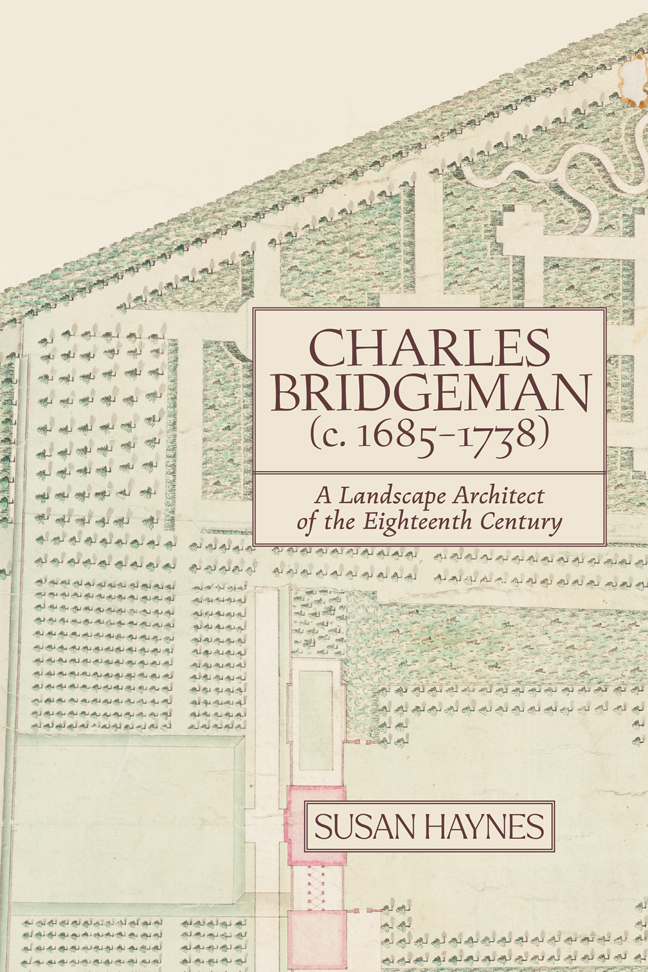Book contents
- Frontmatter
- Dedication
- Maps
- Contents
- List of Illustrations
- Acknowledgements
- List of Abbreviations
- Introduction
- Chapter 1 Who Was Charles Bridgeman?
- Chapter 2 Towards A Reliable Corpus
- Chapter 3 A Revised Catalogue
- Chapter 4 Reading The Plans
- Chapter 5 The Art-Historical Context Revisited
- Chapter 6 The ‘Ingenious Mr Bridgeman’
- Chapter 7 Building a Landscape
- Chapter 8 A Commercial Enterprise
- Conclusion
- Appendix I A summary of Willis's catalogue from Charles Bridgeman and the English Landscape Garden
- Appendix II A revised catalogue
- Appendix III Bridgeman's projects by year
- Appendix IV Bridgeman's income
- Gazetteer of Bridgeman sites
- Glossary
- Bibliography
- Index
- Miscellaneous Endmatter
Chapter 1 - Who Was Charles Bridgeman?
Published online by Cambridge University Press: 21 February 2024
- Frontmatter
- Dedication
- Maps
- Contents
- List of Illustrations
- Acknowledgements
- List of Abbreviations
- Introduction
- Chapter 1 Who Was Charles Bridgeman?
- Chapter 2 Towards A Reliable Corpus
- Chapter 3 A Revised Catalogue
- Chapter 4 Reading The Plans
- Chapter 5 The Art-Historical Context Revisited
- Chapter 6 The ‘Ingenious Mr Bridgeman’
- Chapter 7 Building a Landscape
- Chapter 8 A Commercial Enterprise
- Conclusion
- Appendix I A summary of Willis's catalogue from Charles Bridgeman and the English Landscape Garden
- Appendix II A revised catalogue
- Appendix III Bridgeman's projects by year
- Appendix IV Bridgeman's income
- Gazetteer of Bridgeman sites
- Glossary
- Bibliography
- Index
- Miscellaneous Endmatter
Summary
IN 1714 CHARLES BRIDGEMAN designed a garden for Sir Edward Rolt at his mansion at Sacombe in Hertfordshire. The plan for the landscape, held in the Bodleian Library in Oxford as part of the Gough Collection (BoL MSGD a4 fo.64), is in vibrant watercolour. Beyond the house and formal garden, it shows an axial walk leading to a rectangular canal which stretches out to the southeast of the house. At right angles, another walk stretches through woodland. There is a patte d’oie, one branch of which leads to a small theatre with an oval pond at its base, fed by a conduit from a triangular basin on slightly higher ground. The whole covers 42 acres (0.17km2) and much of it is still visible today, including the outline of the canal and basin in a ploughed field to the south east of the house; to a very large degree it correlates exactly with the plan (https://earth.google.com/web/search/Sacombe). Sir Thomas Rolt, Sir Edward's father, a former Governor of the East India Company, had bought the house and park in 1688. Sir Edward had inherited Sacombe in 1710 (Milledge 2009, 40). It is impossible to say how Bridgeman got the commission. Perhaps it was through a connection with Henry Wise, Royal Gardener between 1704 and 1727, and proprietor of the most prestigious plant nursery in England, Brompton Park Nurseries, for whom Bridgeman probably worked; Wise was clearly known to Rolt and had been paid £8.14s.6d by Rolt in 1714, perhaps for advice, perhaps for plants (Milledge 2009, 40). Possibly it was through Sir John Vanbrugh, the playwright and architect with whom Bridgeman had probably worked at Blenheim Palace and would subsequently work at Lumley Castle and Hackwood. Vanbrugh had designed a walled kitchen garden at Sacombe in the military style. Bridgeman's involvement in the project appears to have been long term, and highly lucrative. Between 13 June 1715 and 1720, the Sacombe estate accounts show that Bridgeman was paid substantial sums, in total amounting to £160,000, the greatest being the final payment of £534. He was still working at Sacombe in summer 1722, when the canal was being dug (Milledge 2009, 42), and was Rolt's principal creditor when his estate was taken into administration on his death from smallpox in the same year.
We have three reliable references to Charles Bridgeman before his triumph at Sacombe.
- Type
- Chapter
- Information
- Charles Bridgeman (c. 1685-1738)A Landscape Architect of the Eighteenth Century, pp. 9 - 24Publisher: Boydell & BrewerPrint publication year: 2023



